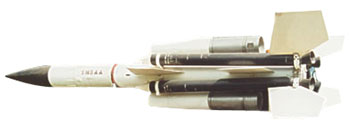British Aircraft Corporation Bloodhound
| Serial No: | n/a |
| Period: | Post-WWII |
| Reference: | 1991/0599/O |
| Museum: | Midlands |
| Location: | National Cold War Exhibition |
| On Display: | Yes |
The development of the Bloodhound Mk2 surface-to-air missile (SAM) began in 1958, with the aim of improving the performance of the already successful Mk1 version. The development involved improving the flight performance, using a Continuous Wave (CW) radar and improving the success rate at low level.
The Mk2 missile was larger with bigger boost motors and Thor ramjets were fitted. The guidance pack was greatly improved to allow the integration of CW radars as ground-based target illuminators. Bloodhound Mk1 radars were based in fixed buildings, which made rapid deployment impractical and required a large scale build and site preparation programme if a squadron move was required.
The Bloodhound Mk2 was available as either a mobile or a transportable missile section. The most noticeable difference between the sections was the type of radar used. The transportable section used the type 87 radar (also known as the Scorpion and codenamed Blue Anchor). The mobile section used the type 86 radar, (also known as the Ferranti Firelight and codenamed Indigo Corkscrew). Mobile sections were deployed all over the world including trials in the desert and in the jungle. This weapon provided the defence system for bomber bases to protect the deterrent force and the industrial heartland of the United Kingdom.






